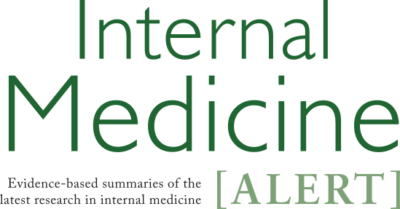
Internal Medicine Alert – February 15, 2015
February 15, 2015
View Archives Issues
-
Influenza, 2014-2015 — Something Old, Something New, and a Mismatch
By early January, influenza activity had reached epidemic proportions in large parts of the United States, despite prior vaccination.
-
Weighing the Harms and Benefits of E-cigarettes
So far, studies evaluating whether e-cigarettes are less harmful than traditional cigarettes remain mostly inconclusive.
-
Hypoglycemia Increases Cardiovascular Risk in Patients With Type 1 and Type 2 Diabetes
This is a retrospective analysis of data from the UK Clinical Practice Research Datalink which includes 265,868 insulin-treated patients age > 30 years diagnosed with diabetes between 2001 and 2007. 3260 were diagnosed with T1DM and 10,422 had T2DM. During a median follow-up of 5 years for type 1 diabetes patients and 4.8 years for those with type 2 diabetes, hypoglycemia was experienced by 573 (18%) and 1463 (14%) of patients, respectively. Compared with patients who did not experience hypoglycemia, the hazard ratio (HR) for CV events among T1DM patients who experienced hypoglycemia was 1.51 (not significant) and 1.61 for those with and without a history of CVD. For T2DM patients, the respective HRs were 1.60 and 1.49. The median time interval between the first hypoglycemia event and the first CV event was 1.5 years for all diabetes patients. Thus, hypoglycemia increases the risk of both CV and all-cause mortality in patients with diabetes.
-
Long-term Payoff of Bariatric Surgery
The benefits of bariatric surgery are gaining new levels of respect as long-term evidence of favorable outcomes — other than cosmetic — continue to accrue. Indeed, in the population of obese diabetics, bariatric surgery is one of the only interventions documented to improve all-cause mortality.
-
Colon Cancer Screening by Stool DNA Testing
Recent guidelines issued by the American Cancer Society and American Society of Gastroenterology recommend colonoscopy as the preferred screening method for colon cancer, but wisely include the philosophy, “The best colon cancer screening test is the test you can get done!” — reflecting the relative reticence shown by many Americans to undergo colonoscopy. CT colonography compares very favorably colonoscopy, yet many insurers are not willing to pay for it.
-
Intracranial Hemorrhage Risk: Are Novel Oral Anticoagulants Better Than Warfarin?
Clinicians have commonly overestimated the risk of intracerebral hemorrhage (ICH) during anticoagulant therapy. Indeed, such misapprehensions have sometimes led to failure to employ warfarin (and probably other agents) when indicated for atrial fibrillation. There is little dispute that novel oral anticoagulants (apixiban, dabigatran, rivaroxaban) are simpler to use, since they do not require monitoring and are essentially free of food interactions. Clinical trials with novel oral anticoagulants (NOACs) have consistently documented that NOACs are associated with lesser risk of ICH, which is certainly a good thing … but how much of a good thing?
-
Alternating Morphology Every-other-beat
Interpretation: The underlying rhythm in this simultaneously recorded 3-lead tracing is a narrow-complex tachycardia.
